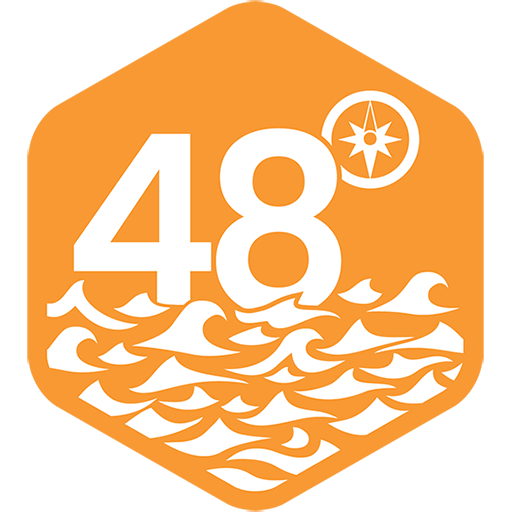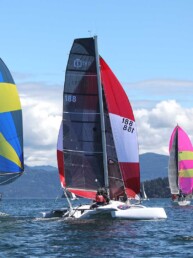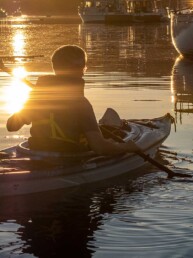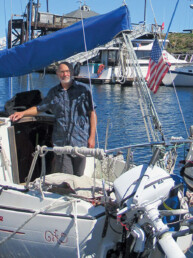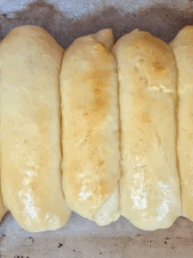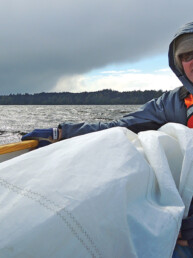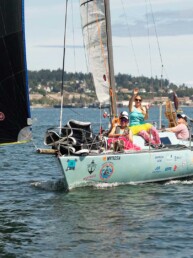The final race of CYC’s Center Sound Series sent racers sailing a familiar course up to south Whidbey Island in lovely conditions.
As March drew to a close, so did Corinthian Yacht Club of Seattle’s Center Sound Series. Like the second race in the series, the final race allows the committee to determine the course on the day of the event, based on the conditions. Accordingly, the committee boat set the line several miles farther north than usual, anticipating more breeze to the north than to the south. Sure enough, when the course was set on the board, it was a 22-mile out-and-back run to Scatchet Head at the south end of Whidbey Island for the 60 boats across nine classes.
The moderate southerly hovering near 10 knots meant a downwind start — which always makes things a little extra exciting. Every kind of start was on display, from the early kite hoist with a speed-and-distance run to the line; to an approach from leeward of the line at the pin end, which puts a boat in a controlling starboard leeward position on all other boats. That is, if they can get back to the pin sailing up against an already pumping springtime ebb. In general, the pin was a very busy spot for these starts, and more than one boat, including the TP52 I was on, managed to be pushed down onto the start pin by the ebb. A penalty turn is not a very fast way to start a race.
Once we got off the line, it seemed like the middle of Puget Sound would provide stronger current and some models suggested the breeze should be better a little farther west too. As happens, the course was pretty even, with possibly even a slight advantage in the first part of the run for the boats whose course kept them closer to the east side.
The breeze was quite consistent for the run north, so soon it was a boat speed game. Gains were minimal, but with more than 10 miles to work with, the faster boats did eventually eke ahead. Boat-to-boat tactics played a role too — on Glory, we sailed a little deeper than we often do for a while, trying to affect the wind of some of our competitors to leeward.
As we approached Scatchet Head, the current was already causing fits as it pushed out of Saratoga Passage, moving boats westward at a healthy clip. With a dark current line to the northwest, the other 52s jibed away to the east; and on Glory, we decided to roll the dice with the split. As it happened, that current line also had a breeze increase, and we extended in the final half-mile on approach to the mark.
We managed to round ahead of our competition by a couple hundred yards, weaving through traffic of the other classes to find a lane around. Once the kite was doused and we were back on the breeze, we let things settle and began the beat by extending southwest on the port tack we’d rounded on. As soon as Smoke and Mist rounded, they immediately tacked. We followed suit. Who could have guessed that those few hundred yards of separation would play such a role in the next leg of the race?
Trimming for speed and height on a close-hauled course to the southeast, the breeze built by a few knots, touching the low teens. It was about six miles on starboard tack as we chewed up the sunny wind waves toward Edmonds. We weren’t very far into this long tack when we started to worry about our position. The other two 52s were showing some mojo — gaining in speed and gauge. We adjusted elements of set-up, but never got rumbling enough to make up the differences. Ultimately, it seemed that our eastward competitors were continually getting the current advantages before we were in the remaining ebb and were able to extend. Talking with sailors from other fleets reinforced this idea — the farther east you were on the beat home, the better.
By the time we tacked on the Edmonds shore, the other 52s had gotten ahead of us,. This was a big advantage with miles of short tacking ahead of us, where they would have a windward position. We tried mightily, but with the only option being short tacks along the shoreline eddy, our friends on the other boats were able to give us their dirty air the rest of the way.
Eventually, the breeze lightened, and the writing was on the wall with the committee boat fast approaching. We took a flier farther west, which didn’t pan out. We crossed the line in third, which wasn’t the result we hoped for, but our competitors had sailed well. Still, it was as good a day as you could ever want for a March sailboat race in the Pacific Northwest. For the series, the three TP 52s all scored 7 points total, with Smoke taking the tie breaker, Glory in second, and Mist third.
Happily sun-kissed and windburned sailors made their way south across the finish line. Most of the fleet behind us had to navigate dying breeze, and leads changed hands in the shifting conditions in several fleets. Top finishers for the day were Farr 395 Ace, Riptide 35 Terremoto, and Ross 930 Gaucho.
Since this race wrapped up an excellent Center Sound Series, please join me in congratulating the best finishing boats overall. Across the three days of racing, the overall podium went to Farr 36OD Annapurna in first, Farr 39CR Tachyon in second, and Custom 40 Madrona in third.
Full results available at Corinthian Yacht Club of Seattle.
Title background photo courtesy of Patrick Doran.
Joe Cline
Joe Cline has been the Managing Editor of 48° North since 2014. From his career to his volunteer leadership in the marine industry, from racing sailboats large and small to his discovery of Pacific Northwest cruising —Joe is as sail-smitten as they come. Joe and his wife, Kaylin, have welcomed a couple of beautiful kiddos in the last few years, and he is enjoying fatherhood while still finding time to make a little music and even occasionally go sailing.
